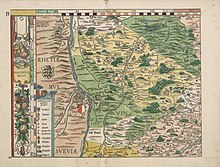Burgstall Bäckerberg (Adelzhausen)
| Burgstall Bäckerberg | ||
|---|---|---|
| Creation time : | 13th Century | |
| Castle type : | Hill castle, moth | |
| Conservation status: | Burgstall | |
| Place: | Adelzhausen | |
| Geographical location | 48 ° 21 '30.5 " N , 11 ° 9' 0.1" E | |
| Height: | 515 m above sea level NN | |
|
|
||
The Burgstall Bäckerberg is the remainder of a high medieval tower hill castle (Motte) of the Lords of Adelzhausen in the district of Aichach-Friedberg in Bavarian Swabia. The ground monument was largely removed by sand mining in the 19th and early 20th centuries.
history
The Motte on the Bäckerberg east of Adelzhausen was built in the 13th century as a successor to an older hilltop castle in the village (today Hauptstrasse 13). This castle stable is documented on the first recording of the NW 11-14 land map (1811) as a typical, round earth cone of a high medieval moth ( Burgstall Adelzhausen ).
The Lords of Adelzhausen first appear in the donation book of the Indersdorf Monastery around 1210 as servants of the aspiring Wittelsbachers . At that time, the Count Palatine acted as guardians of the possessions of the Diocese of Freising . In Adelzhausen, the local founder Adalhelm had already transferred his goods to the Freising Church at the end of the 8th century.

When the Freising goods in Adelzhausen passed into other hands in the 13th century, the Lords of Adelzhausen moved their residence to the nearby Bäckerberg, which was previously called Petersberg and Birkenberg. In the middle of the 14th century, however, the people of Adelzhaus gave up the castle again. In 1360 Martin Adelzhauser sold his "Burchstal" with the associated forest to his cousin Reinbot IV. The purchase price was set at 9 pounds pfennigs. At that time the term "Burgstall" meant a ruin . This ruin appears in 1568 on sheet 13 of Philipp Apian's Bavarian country tables .
description
The two-part system of the fortress can still be seen on the map from 1811 . The main castle was in the west, the outer castle was laid out to the east . Both parts of the castle were of an oval grave plant surrounded. Like the previous castle, the main castle seems to have been located on a tower hill. Sources from 1862 and 1895 report an approximately 10 to 12 meter high, elongated earth pyramid with truncated corners and an almost circular summit plateau. A very similar high moth has survived in nearby Kissing to this day ( Burgstall Kissing ).
By 1910 the castle stables had disappeared apart from remains. From the east, the sand extraction facility was almost completely excavated. Today only tree-lined ramparts on the southwest and northwest sides tell of the castle on the Bäckerberg.
The castle's farmyard ( Sedelhof ) was originally located about 200 meters south on the same ridge. After the residence was given up, the new owners moved the farm down to Adelzhausen. The castle mill was located between the castle and the village on the Ecknach (today Flurstraße 35).
In 1982 the local researcher Sebastian Medele published some reconstruction drawings of the two castle complexes in the commemorative publication 1200 Years Adelzhausen and in the Aichacher Heimatblatt (30) . However, these drawings are free, idealizing interpretations that are not based on archaeological or archival findings.
The Bavarian State Office for Monument Preservation lists the ground monument as a medieval castle stables under monument number D 7-7632-0015.
literature
- Helmut Rischert: The three castles of Adelzhausen (ground monuments in the district of Aichach-Friedberg 3). Flyer for the Open Monument Day 2003.
- Helmut Rischert: The Lords of Adelzhausen and their castles . In: Altbayern in Schwaben - Yearbook for History and Culture 2004. Aichach 2004, ISBN 3-9802017-5-9 , pp. 41–60.
- Georg Paula , Christian Bollacher: Aichach-Friedberg district (= Bavarian State Office for Monument Preservation [Hrsg.]: Monuments in Bavaria . Volume VII.87 ). Karl M. Lipp Verlag, Munich 2012, ISBN 978-3-87490-591-6 , p. 12 .

